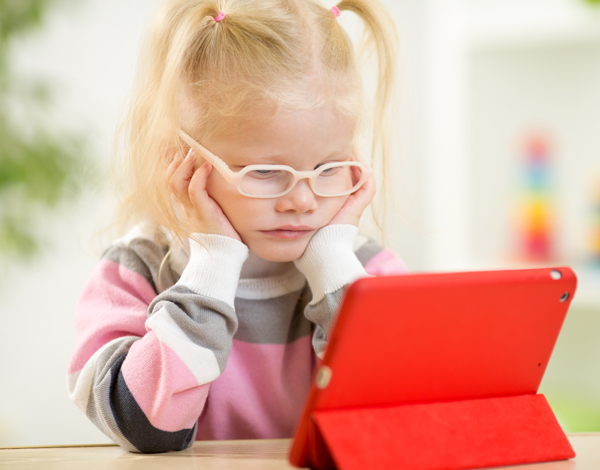Join the thousands of parents already raising smarter, happier babies with our online baby classes: The Active Babies Smart Kids series. Click here.
GymbaROO-KindyROO kids are excelling academically, emotionally, in leadership roles and on the sporting field. Find us at: GymbaROO-KindyROO
A massive health issue related to babies, children and smart devices – screens, tablets, phones and computers, is sight/vision related.
A study in Australia has found that the frequency of myopia, also known as near-sightedness or shortsightedness, in children has almost doubled in the past five years. Another study in the United Kingdom reported that British children are twice as likely to be short-sighted now than fifty years ago, and a study by the National Eye Institute in the USA also found that the incidence of myopia has jumped exponentially in Americans over the last few decades. A global study published by the Brien Holden Vision Institute predicts that half of the world’s population could be short-sighted and need glasses by 2050 with many at risk of blindness.
According to research published in the Ophthalmology Journal, the two clear reasons for the spike in myopia in children, are an increased amount of time spent focusing up close and a lack of outdoor activities.
“Children are spending more time on smaller screens closer to their faces and that puts more strain on their eyes,” says Optometry Australia president Kate Gifford. “Focusing on things too close to the eyes for a prolonged period puts excessive strain on the eyes and has been found to hasten the progression of myopia,” she says.
“When you’re telling your eyeballs all the time that your whole world is only fifty centimeters in front of them, the eye adapts to that.’’
Ms Gifford explained that children’s eyeballs grow too quickly when they strain their eyes by looking up-close too often, resulting in blurred distance vision and the need for glasses. She said that children who spent more than three hours a day focusing at short distances were two or three times more likely to become shortsighted than those who spent less than two hours.
Recent ground breaking research, lead by Australian Associate Professor Scott Read, director of research at QUT’s School of Optometry and Vision Science, confirms the role of outdoor light in reducing short-sightedness in children. Increasing exposure to outdoor light is the key to reducing the myopia (short-sightedness) epidemic in children.
“Children exposed to the least outdoor light had faster eye growth and hence faster myopia progression,” Professor Read said.
Then there’s the ‘blue light’ issue. Optometrist Dr Alexander Du explains: “Light that we see is made up of the colours red, orange, yellow, green, blue, indigo and violet. These colours vary in wavelength and energy. The blue, indigo and violet lights are higher frequency and hence higher energy. Studies suggest that over time, exposure to these high energy blue lights may cause both short and long-term damage to your eyes.”
He goes on: “Every electronic screen emits higher energy blue light. Excess exposure to this blue light to the eyes may cause oxidative stress to the retina, which may lead to macular degeneration in the future. Apart from the oxidative damage to the retina, excess exposure to blue light is also known to disrupt the sleep cycle, which can cause problems in children.”
Experts recommend that to limit blue light exposure and to help prevent myopia from developing and progressing in your children:
- Avoid allowing excessive time spent looking at screens up close.
- Spend plenty of time playing outside, (more than an hour and preferably at least two hours a day).
- If your child wears glasses, a special type of spectacle lens can be used to avoid excessive exposure to blue light. These lenses have a blue light blocking coating that can selectively eliminate the harmful blue light from entering the eye.
Read how to help your baby / child develop crucial visual skills here: Your child’s developing vision: What parents need to know.
Read also: Screen time babes and kids: The latest important information
Bindy Cummings (B.Ed hons) is a teacher and a GymbaROO early childhood neuro-developmental consultant. She is the Editor of GymbaROO’s First Steps magazine, digital articles and media.
References https://blog.chocchildrens.org/effects-of-screen-time-on-childrens-vision/ http://www.telegraph.co.uk/news/health/children/12111882/Children-twice-as-likely-to-be-short-sighted-than-50-years-ago.html http://www.dailytelegraph.com.au/news/nsw/parents-should-limit-kids-screen-time-and-send-them-outside-for-more-green-time-expert-says/news-story/540c082e59be2c25e2d0808042dde5b4 http://www.eyecarekids.com.au/
GymbaROO-KindyROO
Thousands of parents, babies and children are presently involved in our programs and creating rising stars. GymbaROO-KindyROO kids are excelling academically, emotionally, in leadership roles and on the sporting field. Come join all the fun and learning! “GymbaROO – The best decision I ever made for my child.” Classes from 6 weeks old – 7 years GymbaROO KindyROO
Active Babies Smart Kids – Online Baby Classes
GymbaROO-KindyROO’s online series of baby classes is taking the parenting world by storm! It is highly recommended by doctors, paediatricians, early childhood experts and the Maternal Child and Family Health Nurses Association. This series is being called: “The essential guide for parents”. Join the thousands of parents already playing with their babies from birth, in the best way for brain and body development and laying crucial foundations for future learning. What happens in the first year, not only matters, it matters a lot! Enjoy the introductory video below.
Click here: Active Babies Smart Kids online series of baby classes
Try the first episode FREE: Tummy time + baby fun and development class 1
Enjoy the following GymbaROO-KindyROO articles
GymbaROO-KindyROO: Who, what, where, why and how
All about GymbaROO-KindyROO’s online baby classes for parents and babies: Active Babies Smart Kids
How to raise a smarter, happier baby
Screen time babes and kids: The latest important information
Temporal awareness: Helping you child to be a great learner, it’s all in the timing.



